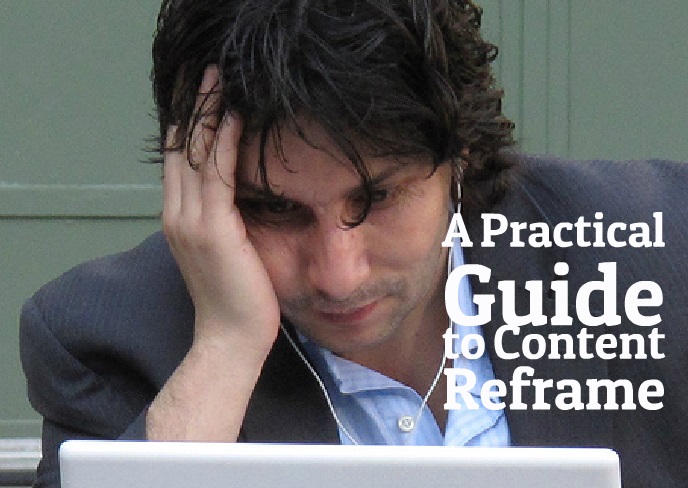
Updated Nov 9 2022
Content reframe can help you to see positive aspects of any situation in life.Take every shove as a push. Take every block as a stepping stone”
- Traditional saying
WHAT IS CONTENT REFRAME?
Content Reframe is the absurdly technical term of reference within Neuro Linguistic Programming (NLP) for what in effect is the mental discipline of putting a positive spin on negative events. When in the grip of unsavoury emotions and unfortunate circumstances, it is easy to feel disempowered; a slave to random events beyond your control. This can in turn lead to a pervading sense of hopelessness, whose poison flower is depression.
Content Reframe is a consciously directed form of positive mental attitude that enables you to wring the best outcome from even the worst situation that life throws at us. It is an example of the way in which NLP takes traditional folk-wisdom and directs it in a scientific manner towards self-improvement. It allows you to “reframe” the “content” of the negative event into a more positive framework.
NLP practitioners sometimes apply Content Reframe to enable people to redefine traumatic events in their past, such as abuse, bullying or injury. However, it is also an effective method of dealing with times of crisis that come upon you unexpectedly.

REAL LIFE EXAMPLE: LOSS OF A JOB
Let’s look at an all-too common real life example that illustrates the practical application of content reframe:
If someone unexpectedly loses their job; the surface outlook can appear bleak. Vacant positions may not be easy to come by, especially when the economy is slow. While this is going on, the humdrum of life continues to take its toll; kids need feeding, bills need paying.
But there is also another way of looking at this situation. Due to being out of work, there are now opportunities to apply for better positions you may not have had time for previously.
You may be able to explore different work opportunities and skills that you hadn’t considered before. The experience itself will also be character building; will make you more self-reliant, daring and courageous. Then there is the issue of perspective; in years to come none of these petty concerns of today will matter. You will be able to look back and laugh at it.
What we have attempted here is to reframe a negative event so that you are free to find positive outcomes within it. It is surprising to realise the blind spots thrown up by negative emotions when you are in the throes of a crisis. Content reframe allows you to step back, take a deep breath and view the situation from a more objective – and constructive, vantage point.
The aim is to focus your attention on the opportunities inherent in any situation, and so to face the future with hope, rather than fear. Long term application of content reframe rewires the natural human tendency to approach change in a spirit of trepidation and fear.
Content reframe does not deny that many situations will have their difficulties; but you are more likely to face them successfully if they are treated as opportunities for growth, rather than defeats.

Tapping into the Unconscious
At some point in life, we all want change. It isn’t only limited to traumatic events but can also be from seemingly mundane things. Wanting it is one thing. Actually going through with the process and making the change stick is a whole other story, and it’s where the difficulty lies.
Why is this so? Change is already tricky all on its own. But why is there a part of us that resists that change after some time too?
The definition of NLP reframing can help in explaining this baffling phenomenon and the endless tug-of-war between change and human resistance. In all its glory, reframing is that way to contact that portion or part of us causing certain behaviors or preventing other behaviors from occurring (Bandler & Grinder, 1979).
Blander and Grinder’s book, Frogs into Princes: Neuro Linguistic Programming, best describes this technique through an example of a married woman who wanted to lose some of her weight.
Let me set the stage. The woman wanted to lose 45 pounds, to be exact. She had managed to lose this weight before. The problem was that every time she managed to lose it, she also regained it back. It wasn’t a matter of losing it, because she was able to. It was more about keeping it off after the weight was gone.
The big mystery of the 45 pounds that kept coming back is that the woman wanted to protect her marriage. Losing weight would attract unwanted attention from other men, which was a nightmare for her because she had trouble saying no. She was using being overweight as a coping mechanism for a situation she believed might end her marriage.
To make NLP reframing work, you’ll need to make the distinction between the intention, which in this case is to protect the marriage, and the behavior — overeating.
The reality that many of us can’t fully comprehend is that if our symptoms work and continually accomplish the intention, a part of us will keep us from changing. Rarely is there one solution to a problem. If you are able to reframe your situation, any situation, it will allow you to change.

The Six-Step Reframing
Now, let’s move on to one of the typical NLP applications known as Six-Step Reframing (Bandler & Grinder, 1979).
Six-Step Reframing is derived from applying NLP models – a model is a formal representation of a behavior that gives way to predictions.
Here is an overview of the Six-Steps:
1. First, you need to identify the pattern (X) or any behavior that you want to be changed.
2. Connect and communicate with the part responsible for the pattern.
Ask if the part causing X will communicate with you in consciousness. Remember to keep track of its response which may be in the form of feelings, sensations, images, sounds, etc. If it’s a yes, increase the intensity of the signal. On the other hand, decrease it if it’s a no.
3. You’ll have to separate the pattern (X) from the positive intention responsible for it. Recognition is vital. You have to be able to differentiate the intention (what you want), and the way that part of you is going about in achieving it (the behavior or pattern).
Communicate with that part running X if it is willing to let you know in consciousness what it’s trying to do for you through the pattern (X). If it’s a yes, ask the part what its intention is. But if it’s a no, continue with unconscious reframing by presupposing positive intention.
Ask that part again if there are other options other than the pattern (X) that will be acceptable or even work better in consciousness.
4. Access the creative inside you to generate NEW behaviors with positive functions in order to arrive at your intended outcome.
Invite the part instigating X and the creative part to collaborate in coming up with better choices to achieve the positive function. Allow the creative part to generate alternatives and have the part that used to run X to choose three.
5. Let the part evaluate whether its new choices are acceptable. Willingness on that part to try out the available alternatives is essential here. That also applies to negotiation. The part that used to run X needs to be happy, or else it won’t try the new choices. If they are not acceptable to the part, go back to step 4 and generate better choices.
In addition, ask the part which sensory signals will trigger the new choices. You’ll have to fully experience those sensory cues to be able to effortlessly and automatically access the alternatives.
6. The last step is to do an ecological check. Ask yourself if there is any part of you objecting to any of the three alternatives. Go back to step 2 if it’s a yes.
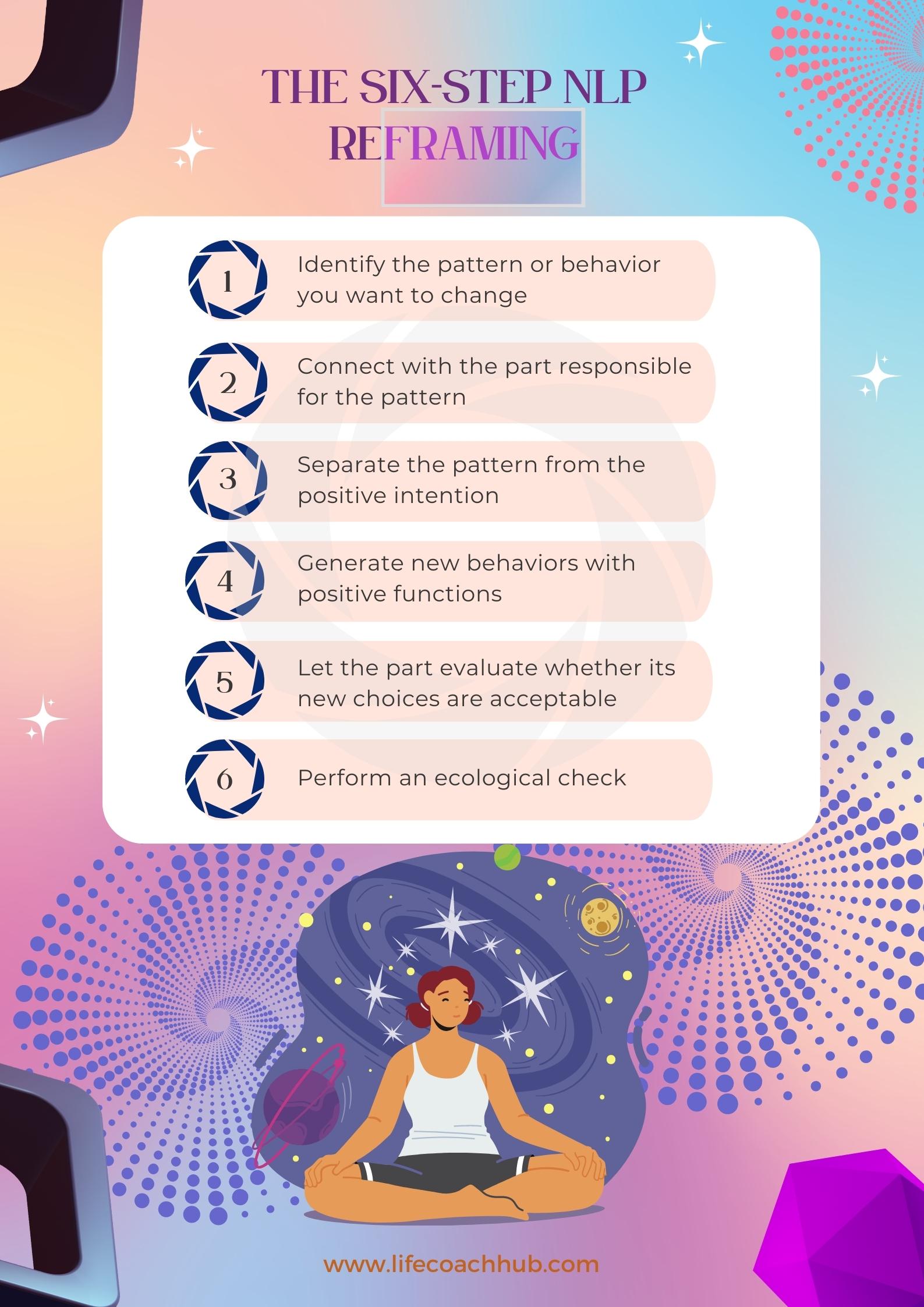
Connecting with that Part
When reframing, relying on primary representational systems such as your feelings, imagery, and sounds is advisable. Words are not that reliable because they are subject to conscious interference, whereas sensations are involuntary (Bandler & Grinder, 1979).
It is not unusual for people to self-diagnose and interpret the messages they receive from their parts. When something uncomfortable surfaces, they designate it as fear. But it can just as easily just be excitement or something akin to aliveness.
If you name a message, you then start acting as if what you just named is indeed the case, thus resulting in internal miscommunication with that part of you. This is a risk that you should avoid. Luckily, you can be sure what a signal means; this is through Step 2: by asking that part of you responsible for the pattern (X) to intensify the amplitude of the kinesthetic, visual, or auditory signals. Performing this can give you a clean channel for communication.
By limiting your focus and attention inwards, you are actually doing what is called trance phenomena. You focus on a signal that is generated internally, and with it are the corresponding physiological changes (breathing, skin texture, color, etc.) known as hypnotic responses.
Change the Context or the Meaning
In NLP reframing, you can either change the context or the meaning of your situation (Bandler & Grinder, 1982).
Changing the context is helpful if you have a particular fixation that you want to be removed. An excellent example would be obsessive-compulsive tendencies. When the mere thought of seeing disarray or any “out-of-place” things drives you insane, your response and behavior may put off other people. All of which may cause a rift in your relationships.
Context reframe
Context reframe can then help you change how you react to that sensory overload by:
- Picturing your fixation while it's in a perfect setting.
- Realizing that keeping it in such a pristine condition comes with being totally alone.
- Adding flaws to it. Because those very same flaws entail that your loved ones are around and by your side.
The last one is much better than something perfect, don't you think?
In this context change, your situation is still as it is. The only difference is the new response that accompanies it.
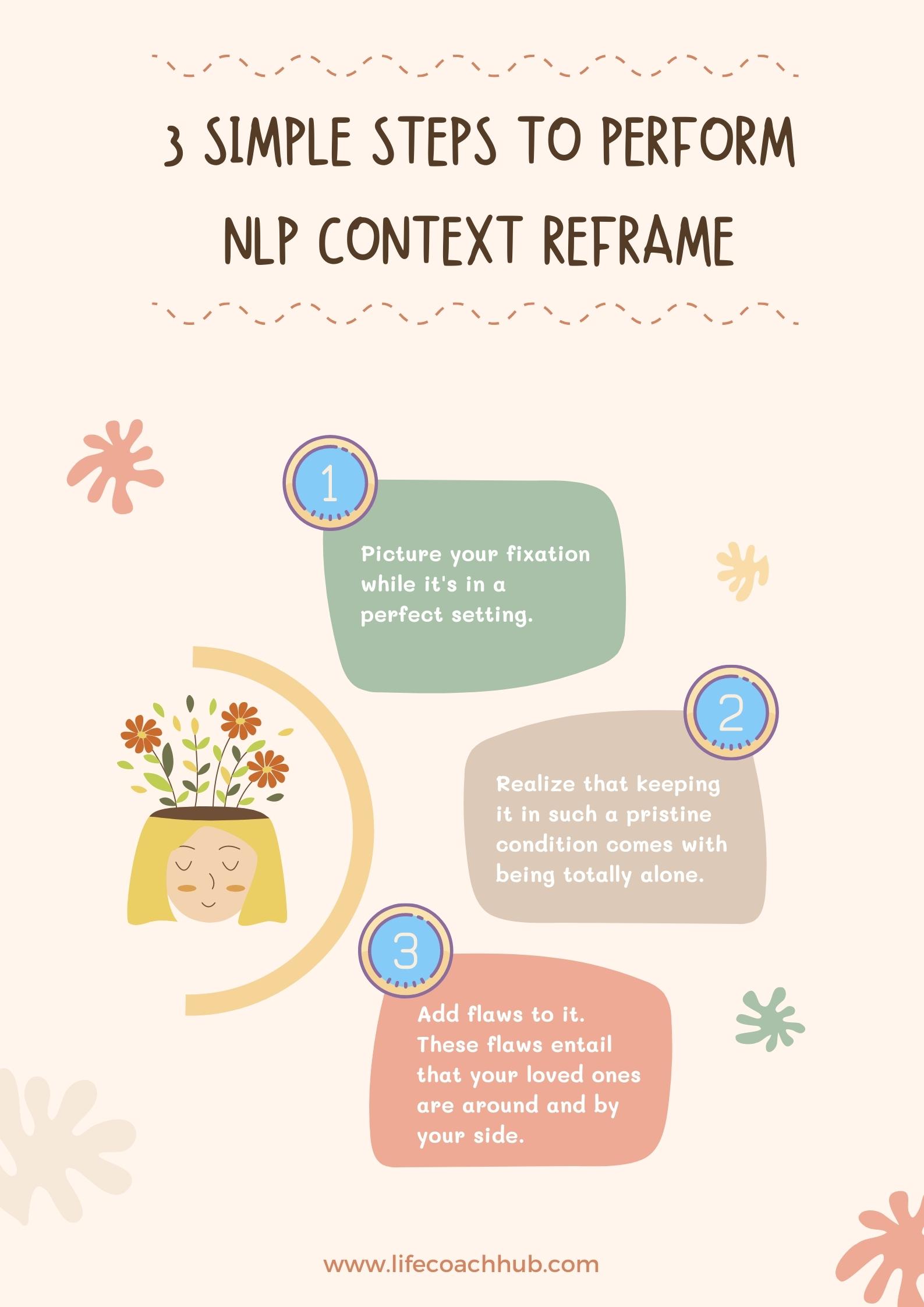
Content reframe
However, when you change the meaning of a situation, you need to:
- Recognize the pattern you want to change
- Familiarize yourself with the behavior generated by that pattern in the picture
- Attach a new name and positive meaning to it
Content reframe is possible because a situation can always have several meanings attached to it. It can be negative, neutral, or leaning toward the positive. Which of these three should apply is totally up to you. So you might as well go for the last one.
As an example, other people might see you as a close-minded person when you strongly disagree with their opinions, yes. But personally, you can opt to think of yourself as someone determined and with conviction. There’s no need to conform to other people’s beliefs if you know full well that theirs aren’t aligned with yours. Acknowledging that varying opinions exist is enough.
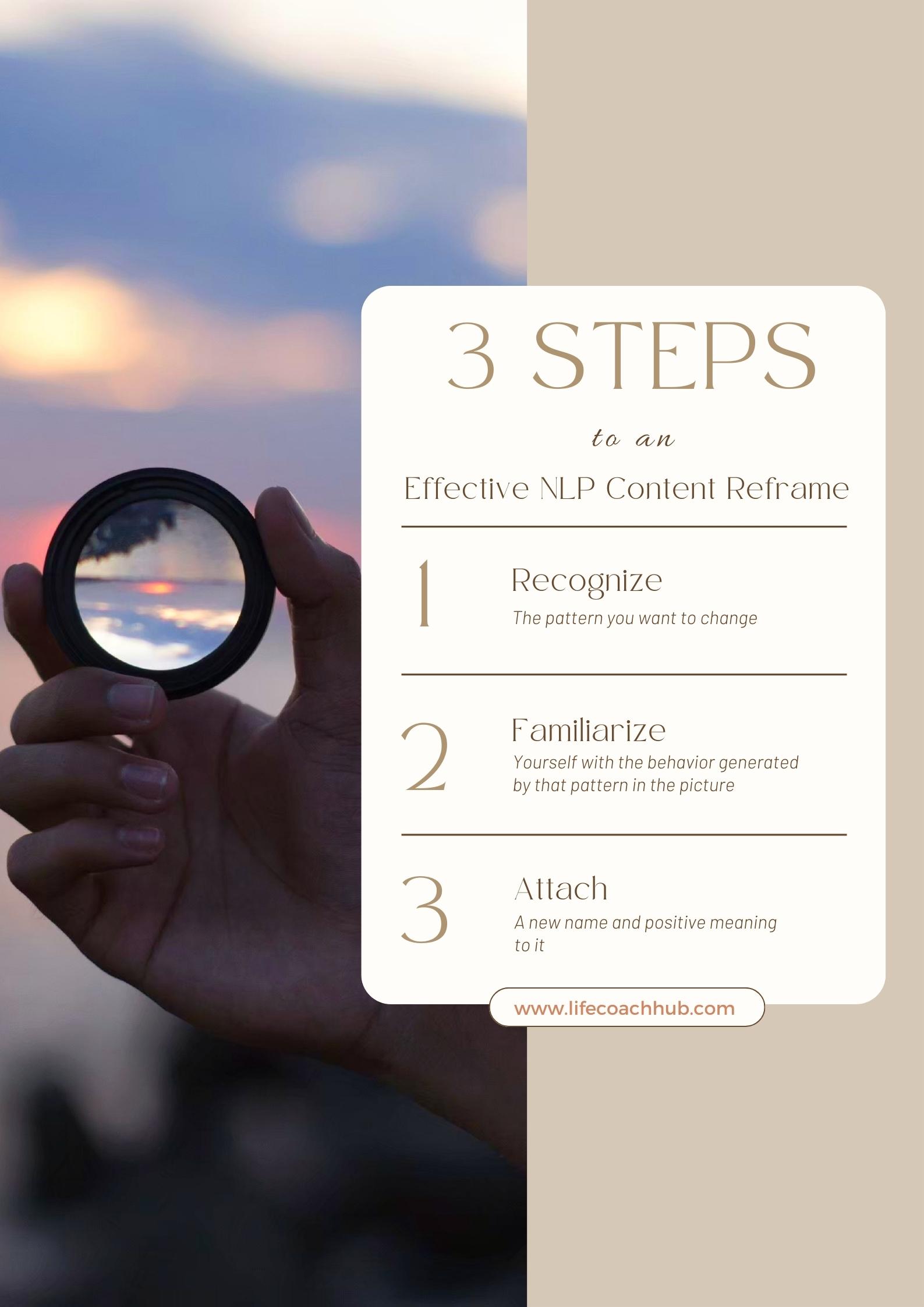
Combining NLP Reframing with Other NLP Techniques
Content reframing is among the basic NLP techniques you can use for self-improvement. You can use them together, especially if one is not enough to get you wherever you want to be.
Rapport
For one, there's the art of rapport, which is especially useful when building meaningful connections with other people. This NLP technique incorporates your words, the tone of voice you use, and your body language.
Combined with NLP reframing, you can use rapport in mending your relationships. Maybe you drove some of your loved ones away because of your neurotic behaviors towards the dirty dishes on the sink (that you firmly believe need to be cleaned right away and in a certain way) or something as small as a crooked placement of a utensil during dinner. You can ease them back to your side once you recognize the disastrous effects of your attitude and use rapport to convince them.
Anchoring
You can also pair content reframing with anchoring by creating an anchor for the emotion you want to feel regarding a particular situation. If you want to feel glad that you're surrounded by the people you love instead of being frustrated at them for leaving things untidy, you can introduce an anchor to access that first emotion easily.
Dissociation
Another technique you can use is dissociation. Dissociation allows you to cut off the link between the triggering event and your negative state of mind. Coupled with content reframing, you can replace what was once a negative reaction with a positive one. Let's take compulsive tendencies as an example again but add phobia to the mix.
Say that the reason why you hate the idea of dirty dishes, imperfect table settings, etc., is because of a childhood memory of you being verbally abused by your mother whenever those situations arise. Your mother's reaction may even be something you adapted as an adult and redirected to your loved ones. Growing up, you developed this intense and irrational fear accompanied by complete avoidance of those anxiety-driven situations (this phobia is called ataxophobia).
What you can do now whenever similar circumstances happen is to dissociate first. By doing so, you reprocess the childhood trauma and make it into something non-threatening. Second, you can fully achieve that transformation by diluting and later on exchanging your negative (and violent) reactions with positive emotions like gratefulness for being surrounded by your loved ones.
Belief change
Lastly, you can also integrate belief change when content reframing. You can alter and prevent the accumulation of negative beliefs when you perform a content reframe.
What may be your initial belief that a sink filled with dishes and a crooked utensil signifies your family as chaotic and not the picture-perfect kind may be reframed into having a home you share with your loved ones.
The new belief is that it's no longer just a house where messy people live. It's a place where family and friends eat meals and share a life together.
Frequently Asked Questions
- What’s the difference between content reframing and context reframing?
Content reframing is when we change our response to a situation. Context reframing, on the other hand, focuses on comparing generalizations.
- Is it possible to reframe criticism?
Yes, it is. You can take criticisms as a form of support. Look at them as revelations about yourself. They can help tell you things that you didn’t know about yourself before.
- What’s a positive frame?
A positive frame is whenever you choose the best perspective to achieve a specific goal. Instead of letting negativities bring you down, you deliberately choose to replace them with a positive mindset.
- What are some of the problems that NLP reframing can solve?
NLP reframing can be helpful in any kind of situation where you feel disempowered or victimized. It is also beneficial for those who have experienced severe trauma in the past. This technique can even be useful for anyone with life-threatening diseases and grief. You take any bad situation and view it in a different light is what NLP reframing is all about.
- What are other NLP techniques can I use for self-improvement?
Besides content reframing, there’s also building rapport, belief change, anchoring, and dissociation. You can check out The Five Best NLP Techniques for Self-Improvement for more information on those individual techniques.
- Can I teach myself NLP?
Yes, you can. It is actually advisable to do NLP techniques on yourself to learn them. Doing so can be valuable to you, especially if you’re an NLP coach or you want to be. If you can use NLP to improve your life, you can also do this for your clients.
- Is NLP the same as therapy?
No, it isn’t — even though many do mistake NLP for some kind of therapy. There’s no need for a person’s mental health history or diagnosis with NLP, which isn’t the case with therapy. In NLP, people don’t have to give their history just to move forward from their current situation.
- How does NLP differ from hypnosis?
NLP is an approach that involves the study of successful people’s strategies and the application of those same strategies to be successful yourself. Hypnosis, on the contrary, is a state involving a person’s focused attention with heightened suggestibility.
- Is NLP a mind control technique?
It isn’t. NLP deals with communication and influence. It uses powerful approaches in managing people’s minds for better responses to situations, yes, but this is in no way mind control.
- What is NLP Coaching?
Through NLP coaching, the self-imposed limitations of clients are brought to the surface in order to work them out and move forward from a certain point in their lives to a better one.
Looking for an NLP coach? Check out our directory here to find the perfect match for you!




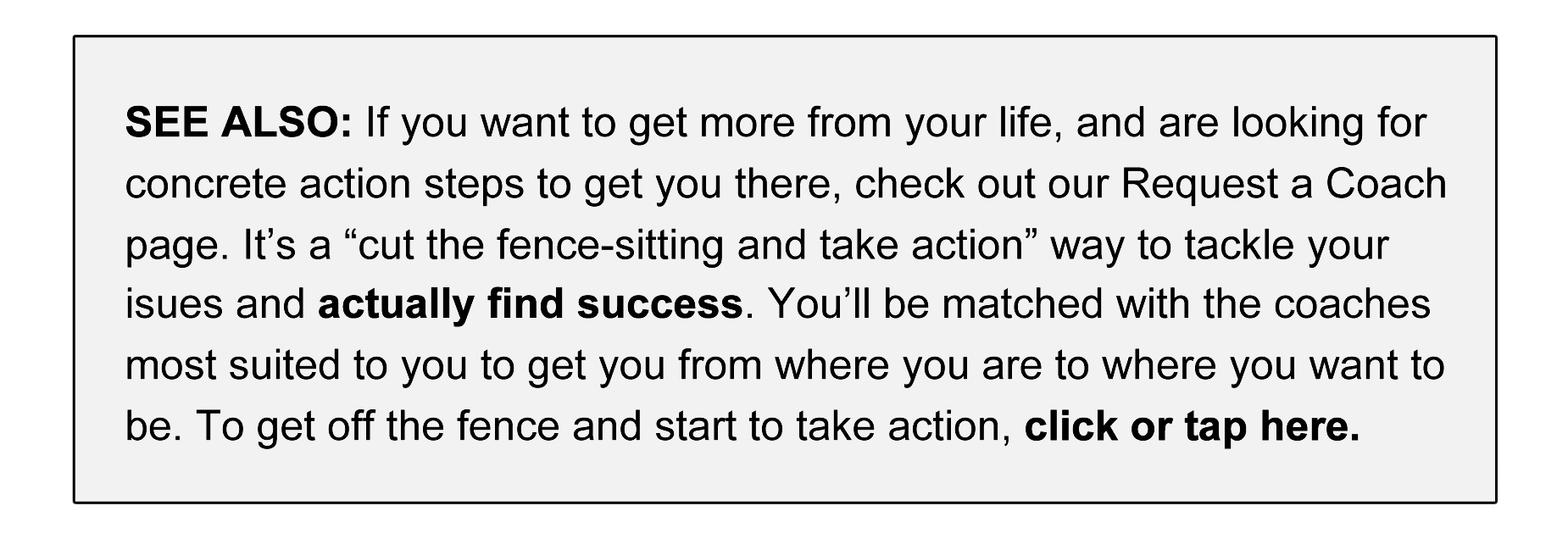

























COMMENTS
sunshine123
October 20, 2022Can someone quote an example when doing a content reframe would not be appropriate- and actually cause the client even more possible stress and anxiety ?